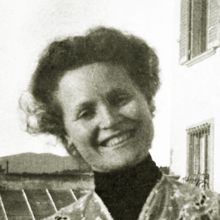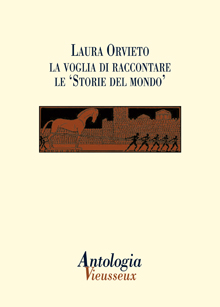Ricerca Veloce
Ricerca Avanzata

Laura Orvieto
Laura Orvieto (Milano, 7 marzo 1876 - Firenze, 9 marzo 1953), scrittrice di cui il Gabinetto G.P. Vieusseux conserva l’archivio, è ricordata soprattutto per le Storie della storia del mondo, ancora oggi ristampate ed accolte con successo dai più giovani lettori.
I suoi libri affrontano con toni scherzosi o fiabeschi i grandi temi ed i personaggi omerici, la mitologia o le vicende dell’antica Roma, messi in relazione con il mondo quotidiano – che si fa cornice dei suoi racconti – e con i “perché” che i più giovani si trovano ad affrontare.
Laura Orvieto (Milan, 7 March 1876 - Florence, 9 March 1953) was the daughter of Achille Cantoni - a landowner from Viadana who moved as a young man to Milan and was a cousin of the writer Alberto Cantoni - and his wife Maria, who was also a Cantoni by birth, from the branch of the family based in Milan. It was there in the Lombard capital that Laura passed her childhood and youth. Achille, passionate about antiquity and antique dealing, was considered "odd" by his family; although he worked in his father-in-law’s bank, he never missed an opportunity to indulge his passion for collecting. He perhaps passed on to his daughter, along with his artistic interests, a certain intimate restlessness. Even as an adult, Laura hid dissatisfactions and aspirations that went back to her juvenile years behind a calmly bourgeois appearance and lifestyle.
In the pages of her autobiography (Storia di Angiolo e Laura [The Story of Angiolo and Laura], published posthumously in 2001), Laura paints herself as an extremely romantic and lively young woman: "for those times, so without seeming to be so, a rebel" (ivi, p.61), yearning above all to find a role for herself in the world. She loved to study, to read, and to identify herself with the vicissitudes of the protagonists of her readings. For this reason - she writes - she devoted herself to Dickens, and immediately determined to become a sort of liberating angel, "to go to London and revitalize the poor neighborhoods" (ibid.).
Two figures were very important to her in her younger years, and encouraged her aspirations: her Scottish governess Lily Marshall, who introduced her to Anglo-Saxon language and literature, and Errera Rose, a teacher at the Normal Schools of Milan, with whom she frequented the first attempts at an after school program in Milan, the Casa e famiglia (House and Family) institutions. She began to spend time with children, telling them stories "that she would make up on the spot, and that delighted her, too. She believed she was inventing new plots and fancies, while probably they were put together out of elements of the innumerable legends and stories of fairies and wizards that she loved so much when the old women would tell them to her as a child, and that she still gladly read" (ivi, p.62). The greater part of Laura Orvieto’s literary production would consist of inventions and narrative reworkings taken from mythology, popular traditions, or her own experience as a mother. She presented these offerings to the world of childhood using extremely simple and clear language, syntax, and organization of events.
In 1898 Laura chanced to meet up with a cousin from Florence, Angiolo Orvieto, whom she had admired from a distance for being a poet, and for a certain romantic aura that seemed to surround him. They were married in October 1899. After her marriage, Laura moved to Florence, entering into contact with the cultural clique of the by then well-established periodical Il Marzocco. But family life, and her two sons, Leonfrancesco and Annalia, born in 1900 and 1903, did not fill her days sufficiently, so Angiolo encouraged her to write. Initially she contributed to the "Marginalia" of Il Marzocco, a column that summarized the most interesting articles from foreign and specialist journals. Very quickly she moved on to proper journalistic articles, for the most part specifically dedicated to women.
Her collection of stories for children was published in 1909 under the name of ’Mrs.El’, a pseudonym she had already used on the pages of the journal. It represents an anecdotal and playful transposition of small family events observed through the eyes of their child protagonists, written while observing her own sons but also reliving feelings and discoveries of her own childhood. In 1911, she began her mythology-inspired ’series’. These are Laura Orvieto’s most famous volumes: her Storie della storia del mondo (Stories of the History of the World) was translated into many languages and is still reprinted today. Myths and legends provided extremely fertile ground for Laura’s imagination, but alongside elements filtered through her reading of Hawthorne, Kingsley or Lang, it is still above all her own personal experience of the relationship with childhood, laid over an episodic and structural path taken from the Homeric tradition, that determined the formulation of the ’stories’.
Although writing for children became Laura’s principle interest, it was not the only one. A friend of Amelia Rosselli, Eleonora Duse and many other protagonists of early twentieth-century culture, she was involved in the Florentine Lyceum, and during the war years she was active in the nurses corps of the Samaritans. This experience encouraged her to venture into the biographical genre, inspiring her Florence Nightingale. At the beginning of the 1920’s she developed a lively interest in Zionist thought and followed its spread through Tuscany, participating in the meetings held in Florence in Via della Robbia, where she met Weizmann and showed great admiration for Ciro Glass.
The bitterness and anger she felt between 1937 and 1939, and the feeling of being inexplicably excluded, led her to write her Storia di Angiolo e Laura (Story of Angiolo and Laura), probably in answer to the first signs of discrimination. It is made up of pen-portraits dedicated to her ancestors and friends, and moments of her own life that she transformed into anecdotes not dissimilar to her many stories for children in their narrative tone. This was not the only manuscript to remain unpublished: other stories, short stories and outlines are to be found among the papers of the Orvieto Archive, at the Gabinetto Vieusseux in Florence. Among these is an unusualStoria del mondo (History of the World, currently in preparation for publication), dedicated to language: the Viaggio meraviglioso di Gianni nel paese delle parole (Gianni’s Marvelous Travels in the Land of Words). Its author defined it as "a grammatical fantasy," in which, once again addressing herself to children, with her customary light touch, she tackles the subject of the individual’s path towards the full awareness of oral expression.
Even during the sad days of the winter of 1943-1944, spent hidden with Angiolo in the Padre Massimo home for the elderly in Mugello while the German troops rounded people up throughout Tuscany, Laura did not forget her writing. Once again she made reference to the tones and rhythms of the novella tradition: this is the case in her brief reports on the Orvietos’ very modest life as "poor old people" like the others accommodated in the Convent, living through days marked out by hope and fear, in the daily repetition of simple peasant activities.
After the war Laura directed the children’s magazine La Settimana dei ragazzi (The Children’s Week) from 1945 to 1947. Many editorial documents from those years are held in the writer’s archives: stories, poems, translations, contributions from and correspondence with her collaborators and young readers. Moreover, there are hundreds of sketches, water colors, and printing proofs, all prepared by various illustrators for the tables of the periodical: a cheerful and brightly colored paper world that seems to sum up all the activities of ’Mrs El’.
Vedi anche...
Venti Donne in Toscana
- € 23,75
- € 25,00
Antologia Vieusseux - n. 53-54, maggio-dicembre 2012
- € 17,00
- € 20,00

